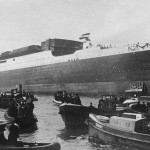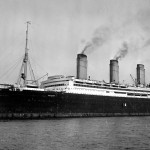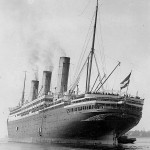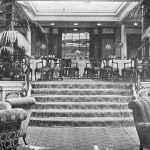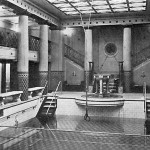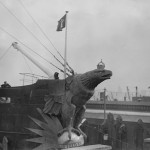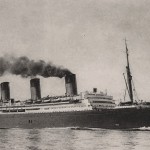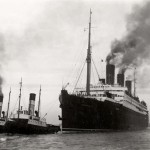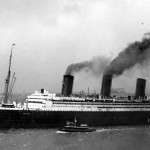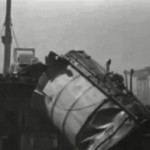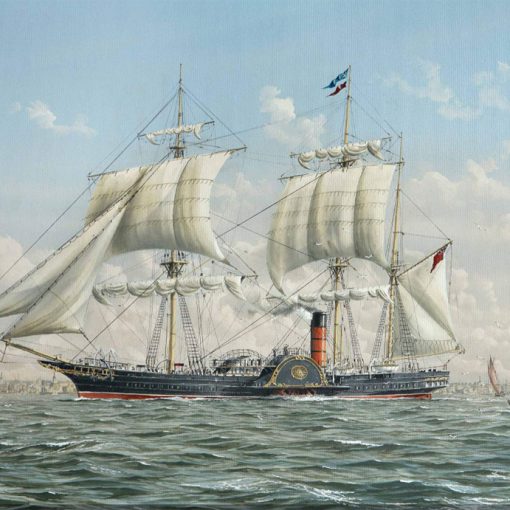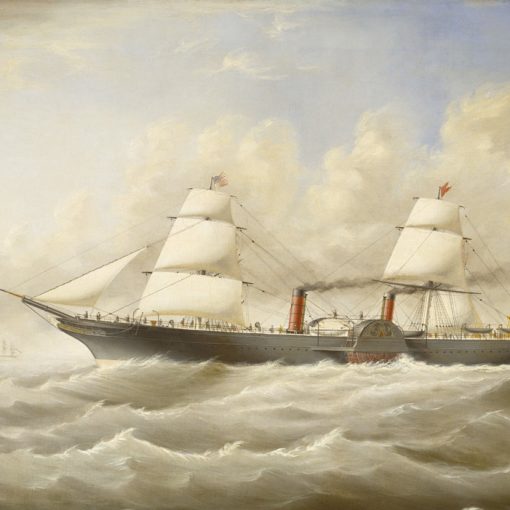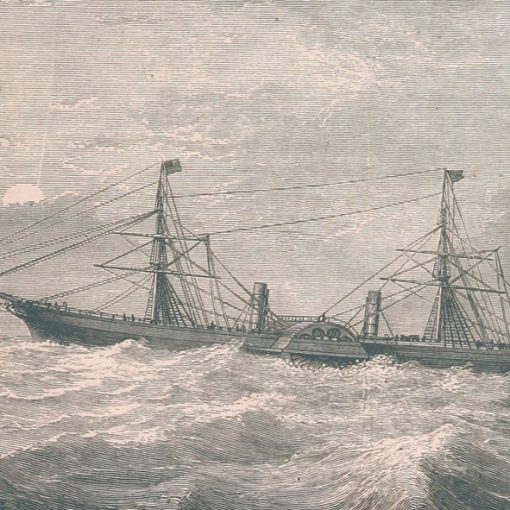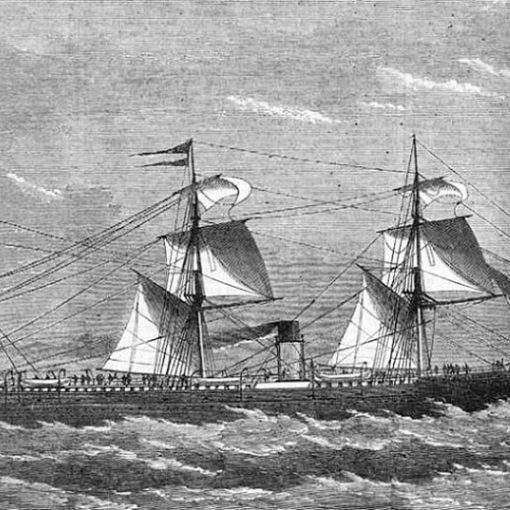1913 – 1938
Also known as Berengaria
Ever since the late 19th century, the Germans had been among the best countries concerning ocean liners. With the swift and fast Kaiser Wilhelm der Grosse of 1897, they had turned the North Atlantic passengers’ eyes to them and the responsible shipping company Norddeutsher Lloyd. Norddeutsher Lloyd opted for speed rather than extreme size. True – the first of the Kaiser-class was the largest ship in existence, but she was quite far from the scrapped Great Eastern’s 19,000 gross tons. The first ship to exceed the tonnage of the Great Eastern was the British White Star liner Celtic of 1901, and this was the first step in countering the Germans. Of course, speed was still mastered by the Germans, but in 1907, the two giant Cunard liners Lusitania and Mauretania entered service and became not only the largest liners in service, but also the fastest. This became the final nail in the coffin for both of the German major trans-Atlantic companies. While the Norddeutscher Lloyd grieved about losing the Blue Riband of the Atlantic, the other big German shipping company – HAPAG – thought of revenge only in terms of size. However, the White Star Line had started construction in 1908 of what was to become three extremely large liners. These three would outmatch the Cunard giants with 15,000 tons each, and they were, of course, the Olympic, Titanic and Britannic. This meant that HAPAG had to surpass 45,000 tons if they wanted to be the largest on the North Atlantic. The speed of Germany’s bid would not be in Mauretania-class, but still not slow.
The director of HAPAG, Dr. Albert Ballin, was to become the creator of the German response. His intention was to build three enormous ocean liners to totally rule the ocean. The first keel plates was laid on June 18, 1910 and already now the future vessel was known as ’the Colossus of the Atlantic’. While White Star’s Olympic would be about 45,000 tons and Cunard’s latest order – the Aquitania – would be the same size as the latter, Ballin could feel sure that his ship was to become the biggest. At best estimates, the new German liner would be over 52,000 tons. By this time HAPAG had decided to name the first of the trio Europa. On the blueprint you could see that the liners would all carry three funnels. The profile of having four funnels was already fifteen years old in Germany, and Ballin wanted to create something new. During construction of the ship, nationalistic German feelings had awakened even more and consequently the ’Colossus’ was renamed Imperator.
The largest blow in ocean liner history occurred in April 1912, when the second of White Star Line’s trio – the Titanic – sunk on her maiden voyage, taking 1,500 people with her into the icy waters of the North Atlantic. This affected shipping companies all over the world. Suddenly all liners had to be fitted with an adequate number of lifeboats. As almost every large vessel on the oceans lacked in life preserving facilities, some vessels would come to look very bad in their new ’costumes’. The identical sister of the Titanic – the Olympic – had had exactly the same inadequateness regarding lifeboats, and she too had boasted to be unsinkable, just like Lusitania and Mauretania. This resulted that these ships were hurriedly fitted with enough lifeboats on a deck space designed for only a small number of boats. The upper decks became a top heavy clutter, but of course, these changes were necessary.
The Imperator was still under construction at the Bremer Vulcan Shipyard in Hamburg when this happened. She now had the advantage of having her over 80 lifeboats fitted while building. From the beginning, she too had had only a small number of lifeboats on the blueprints, but now pieces of the side hull were cut out to create place for the lifeboats in order to smartly rescue the upper decks.
The launch of the Imperator took place on May 23, 1912. The German Kaiser Wilhelm II had taken enormous interest in Ballin’s new trio, and now he was the one to lead the ceremony. Just below where the Imperator’s giant bow towered an ornamented platform had been built for the Kaiser and his staff. The Kaiser himself had dressed in his Admiral suite and he ascended the platform together with Albert Ballin. After the Kaiser’s speech when he was just to christen the ship, a piece of lumber fell from the ship’s bow and nearly hit the sovereign. This was seen as a bad omen by many, but the ceremony ended happily, at least. Afterwards, the Kaiser was presented a three-foot-long silver model of the Imperator by the shipyard officials. He was so delighted that he in turn offered it to Ballin who gladly accepted the gift.
In the late spring of 1913, the Imperator was finished fitting out. The maiden voyage took place on June 13 that year, but it was not as triumphant as everyone had expected it to be. She was certainly the largest and most luxurious ship that the world had to offer, but added to this she was top heavy due to large public rooms high up in the hull and too high funnels. Consequently, HAPAG had her funnels shortened with nine inches, all heavy material on the upper decks replaced with lighter replicas and tons of cement poured along the ship’s bottom. This helped somewhat, but instability would always haunt the Imperator.
But in spite of these problems, the world’s eyes were turned towards the Imperator. She was the largest ship ever created both in tonnage and length. Her exteriors as well as her interiors were something fantastic. The three-funnel design seemed to work quite well, and you could easily spot the resemblance with the British White Star Lines Olympic-class. Something that did not resemble with the Olympic was the amount of gilding the ship sported. For instance, the downside of the overhanging stern was decorated with a gold painted ornament in consequence to Norddeutscher Lloyd’s Kaiser-class. In order to secure being the longest ship in the world a spectacular figurehead in form of an eagle with outstretched wings had been added at the forepeak. The eagle was standing on a globe representing the Earth with a banner saying ’Mein Felt ist die Welt’ (My Field is the World). This kind of ornament had not been the custom since the days of the sailing ships with clipper bows, and this addition to the Imperator’s blunt bow seemed a little bit out of place. Nevertheless, after some time when you got used to the image, it looked quite good. This feature stayed at its place until a violent storm broke off its wings, and suddenly the wings’ field became the ocean floor. The remaining body was removed as soon as possible, never to be replaced.
The interiors showed some of the most beautiful features the world had ever seen on board a ship. The enormous Social Hall was large enough to accommodate at least a hundred people and had a huge dome that capped the ceiling. The room also contained a marble bust of the Kaiser. This bust was one of the things that were replaced when remedying the ship’s instability. Domed was also the first class dining room. In the centre of the room the round captain’s table stood overlooking the rest of the magnificent room. Another sparkling feature was the first class indoor swimming pool. It was the grandest on the oceans modelled after the slightly smaller Royal Automobile Club’s pool in London. However, it was not the first swimming pool on the high seas. The 1907-built White Star liner Adriatic was the first ship with such a facility. Another extraordinary room was the ship’s gymnasium. Situated in the ship’s hull rather than on the boat deck as on the Olympic the feeling was more cosy and private. Here, millionaires would mix with ’ordinary’ first class passengers in order to speak men to men and to get away from their wives. One large part of the interior that did not live up to the Imperator’s competitors was her steerage areas. The steerage dining room was situated in the foremost part of the ship with slanting walls. The tables were long and packed together, and there were no chairs as on the Olympic-class, but long benches to sit on. In spite of having these inadequate facilities, HAPAG expected to ship a great amount of passengers, especially emigrants – the Imperator had room for nearly 5,000 passengers plus crew.
In 1914, the second of Ballin’s trio entered service. She was the Vaterland, and she had a gross tonnage some 2,000 tons higher than the Imperator. Added to this, she was 31 feet longer than the Imperator who now was replaced as the largest ship in the world. Shortly afterwards, the third of the class was launched. She was the Bismarck, and with a proposed 56,000 tons she would not be exceeded in size until the mid-1930s.
Shortly after this, the First World War broke out. At the time, the Imperator was at New York harbour. The Germans thought it to be a safe place for the second grandest ship in their merchant fleet. But after the German sinking of the Lusitania the United States soon decided to enter the war on the British/French side. The Imperator remained in her uncertain position for the rest of the war, but as the Germans eventually lost the ship was confiscated by the American Government. For some time after the war she sailed as the USS Imperator to bring back American troops home. But the British required reparations for their lost Lusitania, and when the Imperator had finished with her American duties, she was handed over to Great Britain as a replacement to Cunard. As if this was not enough, both HAPAG’s other prime ships – the Vaterland and the Bismarck – were also seized by the victorious states. Vaterland went into American hands and became their Leviathan, while Bismarck was renamed Majestic replacing White Star’s lost 48,000-tonner Britannic. The Imperator was renamed Berengaria by Cunard. This was the first time a Cunard ship had had this name, and furthermore it was the first time a Cunard ship was not named after one of the Roman provinces. ’Berengaria’ was the name of Richard Lionheart’s wife. Before the new Berengaria could enter British service there were several small things that had to be changed as well as major refittings. All the signs inside the ship had to be changed from German to English, and on the outside the yellow HAPAG-funnels were repainted in Cunard’s customary orange-red colour with black tops. Two black bands were painted on the orange-red section in order to divide the funnel into four sections. However, if you took a closer look you realised that the four sections were not equal. This created an asymmetry that badly matched Cunard’s sense of perfection.
The Berengaria’s new running mates became the Mauretania and the Aquitania, making the three ships into a very distinguished trio. They became known as ’The Big Three’. All three ships had their own special distinction. The Mauretania was still the fastest liner in the world, the Aquitania was the longest British built ship and the Berengaria was the largest Cunard ship at the time, having the rank of flagship. Being the flagship of such a prestigious shipping company as Cunard meant that the world’s top clientele chose to sail on her. In 1924, the Berengaria carried the future Edward VIII. At the time he was still the Prince of Wales, but yet he travelled in disguise as ’Lord Renfrew’. However, this did not fool anyone and soon the Prince became a popular passenger in his own role. Other noted names were Will Rogers, Mary Pickford, Douglas Fairbanks, Henry Ford, Junius Pierpont Morgan and the Queen of Romania. Several of the famous families of Astor, Vanderbilt and DuPont also chose the Berengaria for their Atlantic crossings.
In 1929, the terrible crash at Wall Street occurred and this soon affected the whole world. People suddenly had less and less money, and some of the richest were ruined. An expensive Atlantic crossing was something few people could afford. This soon started to hit the shipping companies more and more, and they had to sell out their voyages cheaply, making ’booze-cruises’ for thirsty Americans tired of prohibition. The prices became that low on the Berengaria that she became known as the ’Bargain-area’.
The hard times prevented the shipping companies from updating their fleets, and the Berengaria remained in the position of flagship until May 1934, when Cunard and White Star Line joined forces, and then she gave the honour to her own former sister the Majestic. Of Ballin’s once great German trio, at least two now served in the same company. In 1935, the French liner Normandie arrived and replaced Majestic as the largest ship in the world with her 79,280 gross tons. A year later, Britain finally managed to produce a first class ship to rule the waves. She was the 81,000-tonner Queen Mary, and with her arrival on the North Atlantic, ships like the Berengaria seemed hopelessly outdated. To make matters worse, the hull of the ship showed clear evidence of being old. And like so many other old ships, the Berengaria suffered from constant fires in her interiors. Eventually, it had gone that far that the American Government forbade its citizens to sail on the Berengaria. Being a severe blow to Cunard, they naturally protested, but as another fire broke out Cunard had to face it. The great Berengaria was sold to ship breakers in Jarrow in 1938. The former Imperator was not an easy task and the entire ship was not gone until after World War II in 1946.
Specifications
- 919 feet (280.7 m) long
- 98 feet (29.9 m) wide
- 52,226 gross tons
- Steam turbines powering four propellers
- 23 knot service speed
- Passenger capacity of 4,594 people

